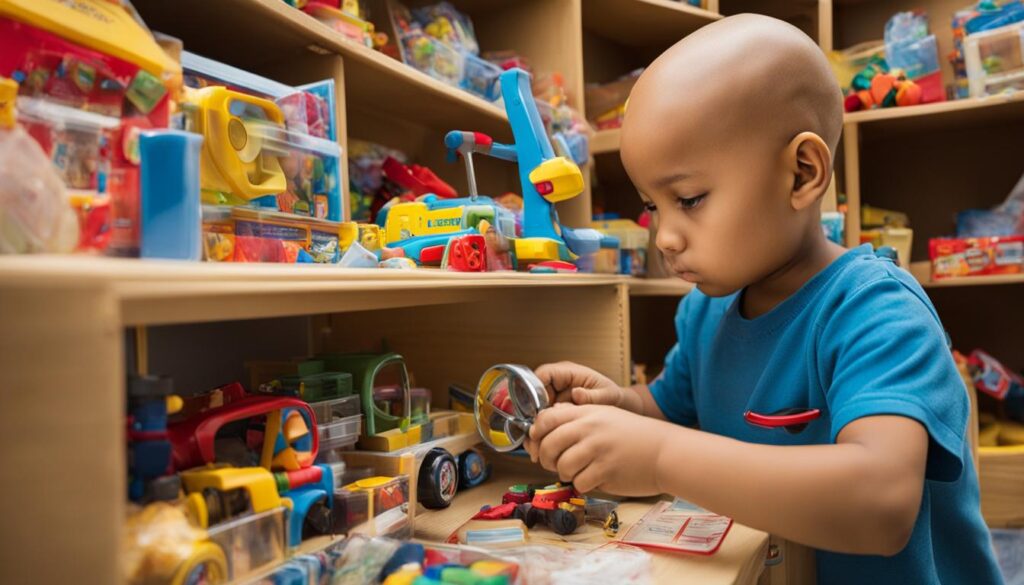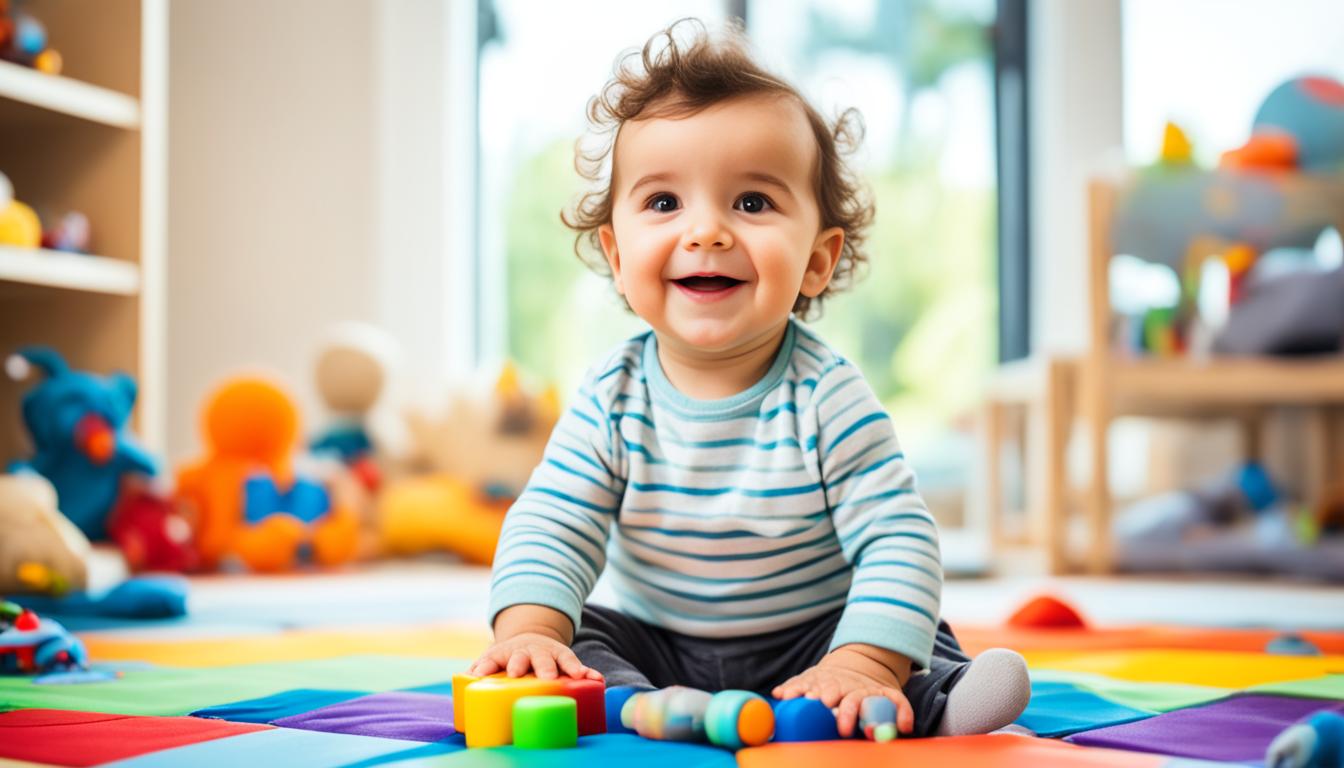Disclosure: This Post Contains Affiliate Links; We earn a commission on purchases.
Play is essential for the physical, emotional, and cognitive development of children. It is important for kids to engage in safe, screen-free activities that promote healthy playtime. Outdoor play is especially beneficial, as it allows children to exercise their bodies, foster imagination, develop motor skills, and enjoy fresh air. According to the Cancer Center for Healing in Irvine, CA, non-toxic toys are important for pediatric cancer patients’ overall well-being. These toys should be free from harmful chemicals and provide a safe and engaging play experience. It is crucial to choose toys made from natural, organic, or non-toxic materials and look for safety certifications to ensure they meet safety standards. By selecting non-toxic toys, parents and caregivers can support the healthy playtime of their children and contribute to their well-being.
Key Takeaways:
- Engaging in safe, screen-free activities promotes healthy playtime for children.
- Outdoor play allows children to exercise, foster imagination, and develop motor skills.
- Non-toxic toys are important for the overall well-being of pediatric cancer patients.
- Choosing toys made from natural, organic, or non-toxic materials is crucial.
- Looking for safety certifications ensures the toys meet safety standards.
Benefits of Outdoor Play for Kids
Outdoor play offers a multitude of benefits for children, supporting their physical, emotional, and cognitive development. Engaging in outdoor activities allows children to explore, discover, and learn through active play. Here are some key advantages of outdoor play:
- Physical Development: Outdoor play provides opportunities for children to exercise their bodies, develop gross and fine motor skills, and enhance coordination. They can run, jump, climb, and engage in physical activities that promote strength, endurance, and overall physical well-being.
- Cognitive Development: Outdoor play stimulates children’s cognitive abilities, including problem-solving, creativity, and critical thinking. It encourages them to explore their environment, make observations, and engage in imaginative play. Nature offers a rich sensory experience that fosters curiosity and cognitive growth.
- Importance of Fresh Air and Vitamin D: Spending time outdoors exposes children to fresh air, which can improve respiratory health and strengthen their immune system. Additionally, sunlight provides a natural source of vitamin D, which is crucial for the development of strong bones and overall well-being.
- Fostering Love for Nature: Outdoor play allows children to connect with the natural world, fostering a love for nature and environmental awareness. Exploring gardens, parks, and natural landscapes encourages children to appreciate the beauty and wonders of the outdoors, while also instilling a sense of responsibility for the environment.
Encouraging children to engage in outdoor play is essential for their healthy growth and development. Besides the physical and cognitive benefits, it nurtures a lifelong appreciation for the outdoors, promoting an active and nature-conscious lifestyle.
Statistics on Outdoor Play Benefits
| Benefit | Statistics |
|---|---|
| Physical Development | Children who engage in regular outdoor play have better motor skills and physical fitness levels compared to those who have limited outdoor time. |
| Cognitive Development | Spending time in nature has been linked to improved concentration, creativity, and problem-solving abilities in children. |
| Mental Health | Outdoor play has been shown to reduce stress, anxiety, and symptoms of attention deficit hyperactivity disorder (ADHD) in children. |
| Immune System | Exposure to diverse environments and natural elements during outdoor play can strengthen the immune system of children. |
These statistics highlight the positive impact of outdoor play on children’s overall well-being and development. Incorporating regular outdoor playtime into their routine can have long-lasting benefits.
Outdoor play is not just a way for children to have fun; it is an essential component of their growth and development. It provides them with opportunities to explore, be active, and connect with nature, fostering their physical, cognitive, and emotional well-being. Let’s encourage and prioritize outdoor play for children, ensuring they have access to the numerous benefits it offers.
Fun and Screen-Free Outdoor Play Ideas for Kids
When it comes to outdoor play, there are endless possibilities for keeping kids entertained and engaged. Whether you have toddlers, kindergarten, or primary school children, these fun and screen-free outdoor play ideas are sure to keep them active and happy.
Outdoor Play Ideas for Toddlers
- Chase and Hide-and-Seek: Simple games like chase and hide-and-seek are perfect for toddlers and preschoolers. They encourage physical activity and develop their motor skills.
- Sensory Play in Nature: Let your little ones explore the great outdoors by playing with washable toys in the grass and dirt. This sensory experience will enhance their tactile and sensory development.
Outdoor Activities for Kindergarten and Primary School Children
- Treasure Hunts: Organize treasure hunts to engage older children in an exciting adventure. Hide clues and treasures around the yard or local park, encouraging problem-solving and teamwork.
- Outdoor Art with Eco-Friendly Chalk: Let your children unleash their creativity by creating beautiful masterpieces with eco-friendly chalk. They can draw on the sidewalk or pavement, nurturing their artistic abilities.
- Hopscotch: Bring back this classic game that promotes balance, coordination, and counting skills. Draw a hopscotch grid using chalk and have your kids hop their way to victory.
- Forest Cubby Houses and Nature Obstacle Courses: Encourage children to build their own cubby houses using natural materials found in the forest. They can also create obstacle courses with fallen branches, rocks, and other elements of nature, enhancing their problem-solving and creativity.
Eco-Friendly Games and Activities for Kids
Engaging kids in eco-friendly games and activities can teach them the importance of sustainability and environmental consciousness. Here are some ideas:
- Plant a Garden: Involve your children in planting and tending to a garden. They will learn about the life cycle of plants, the importance of nurturing the environment, and can enjoy the fruits of their labor.
- Nature Scavenger Hunt: Create a nature-themed scavenger hunt where children have to find specific leaves, flowers, or rocks. It encourages them to explore and learn about the natural world.
- Recycled Art Projects: Encourage kids to unleash their creativity by making art using recycled materials like cardboard, plastic bottles, or newspapers. This activity promotes recycling and creativity at the same time.
Sensory-Friendly Outdoor Play
For children with sensitivities, engaging in sensory-friendly outdoor play can be enjoyable and beneficial:
- Textured Toys: Provide textured toys that stimulate different senses, such as toys with various fabrics, textures, or tactile surfaces.
- Calming Sensory Playsets: Create a calming sensory playset with materials like sand, water, or rice. This can help children relax and engage their senses in a soothing way.
Interactive and Educational Toys
Interactive and educational toys not only entertain but also promote learning. Consider these options:
- Science Kits: Spark your child’s curiosity with science kits that allow them to conduct experiments and learn about the world around them.
- Musical Instruments: Encourage your children to explore their musical talents by providing them with musical instruments like drums, keyboards, or guitars.
- Educational Board Games: Engage children in educational board games that promote critical thinking, problem-solving, and social skills.
By implementing these outdoor play ideas and providing suitable toys, parents and caregivers can ensure that kids have a safe, engaging, and educational playtime experience that fosters their development.
Remember, outdoor play is not only fun but also essential for children’s physical and cognitive growth. Encourage them to get outside, explore, and enjoy the beauty of nature!
Toy Safety Tips for Pediatric Cancer Patients
When it comes to selecting toys for pediatric cancer patients, safety should always be the top priority. Ensuring that the toys are safe, non-toxic, and age-appropriate is crucial for the well-being of these children. Here are some guidelines to follow:
Choosing Age-Appropriate Toys
Opting for toys that are suitable for the child’s age and developmental stage is important to minimize the risk of accidents and injuries. Age recommendations are usually provided on toy packaging, making it easier to select the right toys for pediatric cancer patients.
Avoiding Harmful Materials
To protect children with weakened immune systems, it is essential to choose toys made from non-toxic materials. Avoid toys that contain harmful chemicals such as lead, phthalates, or BPA. Reading labels and checking for safety certifications can help ensure compliance with safety standards.
Cleaning and Maintenance
Regularly cleaning and sanitizing toys is crucial for preventing the spread of germs and bacteria. Use non-toxic cleaning products that are safe for children. Follow the toy manufacturer’s instructions for cleaning and maintenance to prolong their lifespan and ensure continued safety.
Avoiding Choking Hazards
Small parts pose a significant choking hazard, especially for younger children. It is important to avoid toys that have loose parts or small components that can easily come off. Carefully inspect toys for any potential choking hazards and remove them before giving them to pediatric cancer patients.
By following these toy safety tips, parents and caregivers can ensure that the toys pediatric cancer patients play with are safe, non-toxic, and supportive of their overall well-being.

| Toy Safety Tips | Description |
|---|---|
| Choosing Age-Appropriate Toys | Select toys that are suitable for the child’s age and developmental stage to reduce the risk of accidents and injuries. |
| Avoiding Harmful Materials | Opt for toys made from non-toxic materials and avoid those containing harmful chemicals such as lead, phthalates, or BPA. |
| Cleaning and Maintenance | Regularly clean and sanitize toys using non-toxic cleaning products to prevent the spread of germs and bacteria. |
| Avoiding Choking Hazards | Inspect toys for small parts that may pose a choking hazard, especially for younger children. |
Conclusion
Providing safe playtime activities for kids is crucial for promoting their physical, emotional, and cognitive development. Encouraging outdoor play not only offers numerous benefits but also fosters a love for nature. Selecting non-toxic toys made from natural materials ensures a safe and engaging play experience. Age-appropriate toys that stimulate learning and creativity further enhance children’s development.
Considerations for pediatric cancer patients are of utmost importance. Opting for non-toxic toys and following safety guidelines ensures their overall well-being. By prioritizing safe play and providing suitable toys, parents and caregivers can contribute to the healthy development of their children.
Remember, engaging and educational toys play a vital role in the growth of children. By incorporating them into playtime activities, kids can learn and have fun simultaneously. By adopting these practices, we can promote healthy play habits and prioritize the well-being of children, ensuring they have a safe and enjoyable playtime experience.
Source Links
- https://cancercenterforhealing.com/non-toxic-toy-recommendations-for-pediatric-cancer-patients/
- https://community.whattoexpect.com/forums/all-natural-birth-group/topic/emf-concerns-re-owlet-nanit-best-one-or-best-alternative-110598327.html
- https://livingsafe.com.au/fun-eco-outdoor-activities-for-kids/

Subscribe to Our Newsletter










